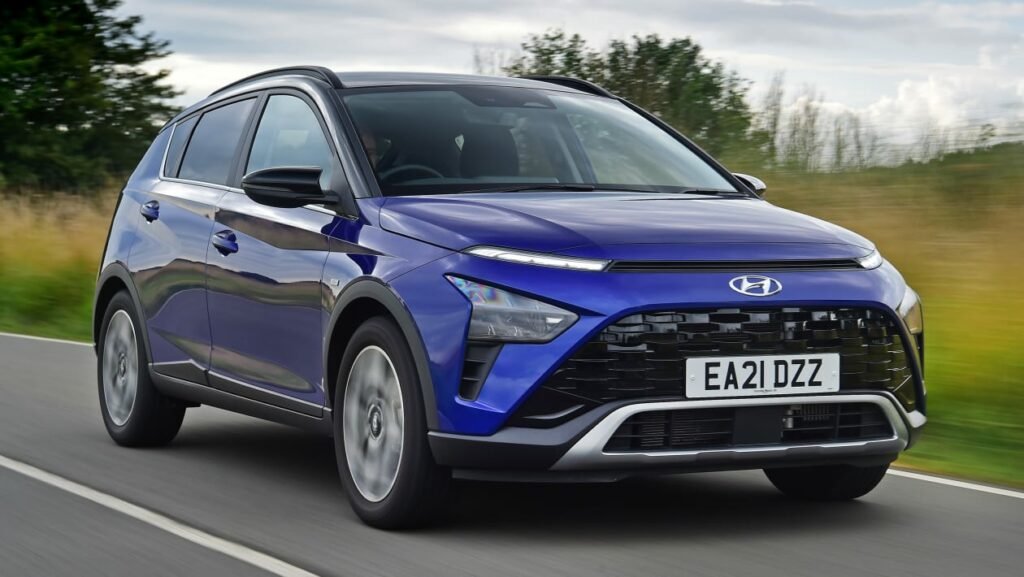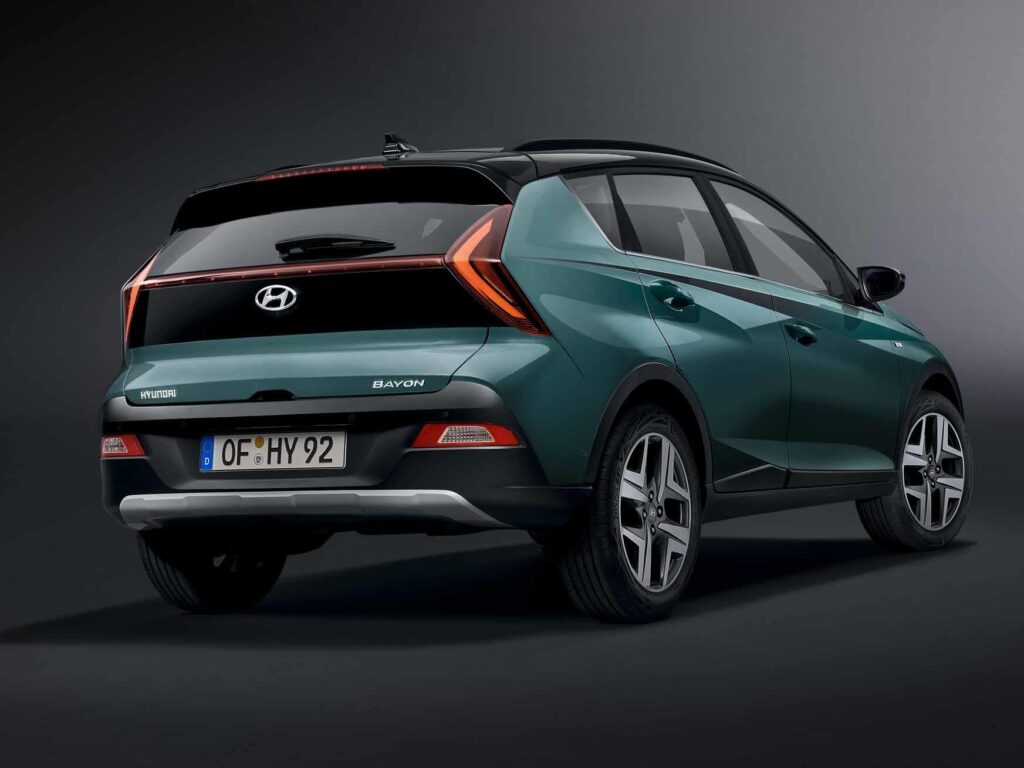The Hyundai Bayonne is a great little SUV, with stunning looks, impressive levels of refinement and useful technology on board
The Hyundai Bayon is a small SUV that competes with the Skoda Kamiq and SEAT Arona, and although its design is really eye-catching, it is actually very conventional. It offers a no-nonsense package that’s practical, well-equipped and easy to drive, though it doesn’t stand out when it comes to the driving experience or with its cabin. But, it makes the little things right and we think it’s a perfect fit for the buyers you’re targeting.
There are many alternatives. If you want a good-to-drive compact SUV, there’s the Ford Puma, or if you want a more luxurious vehicle, try the Volkswagen T-Cross. However, if you like the look of the Bayon, it’s worth considering it as a small but practical family car.
The Hyundai Bayon is a small SUV that competes with the Seat Arona, Volkswagen T-Cross, Skoda Kamiq and Ford Puma. There are plenty of other competitors too, including the Peugeot 2008, Renault Captur, Citroen C3 Aircross, Vauxhall Mokka and more – it’s a very saturated part of the market.

In order to help the new model stand out, Hyundai has given the Baiyun an unusual exterior look, despite its ordinary underpinnings – it’s based on the same parts kit as the i20 supermini.
The slim lights, split grille and angular bodywork at the front give it a unique face, while the rear end has a curvy look with inward-pointing taillights and only a small section of painted bodywork on the tailgate. The looks also help the Bayon stand out from the more traditional Hyundai Kona, which is another small SUV to consider.
While the Kona has hybrid and even high-performance ‘N’ versions, the Bayon is offered with just two engines, both 1.0-litre three-cylinder petrol. The first has 99 hp and 172 Nm of torque, while the second has 118 hp but the same 172 Nm of torque. Both use 48-volt mild hybrid assistance to enhance efficiency, and are available with a six-speed manual transmission or a seven-speed dual-clutch automatic gearbox.
The trim lineup starts with SE Connect, which has 16-inch wheels, automatic high beams, cruise control, rear parking sensors, a 10.25-inch screen behind the steering wheel and an 8-inch touchscreen center display with smartphone connectivity.
Premium is next and adds 17-inch wheels, tinted windows, LED headlights, and a larger 10.25-inch touchscreen. The top-spec Ultimate model has some extra kit including a Bose stereo and upgraded trim but is probably not worth the upgrade.
Motor performance in the Hyundai Bayon
There are only two engines, both 1.0-litre petrols with mild-hybrid power, but you can choose manual or automatic gearboxes.
The Hyundai Bayonne is typical of the ultra-small SUV segment – easy to drive but not exactly fun. The Ford Puma is in keeping with this trend, being more fun than other cars of its type, but most other small SUVs focus more on comfort and ease of use. Hyundai is suitable in this way.
The steering wheel, gearbox and pedals are all very light and offer no feel or feedback. You can switch to Sport mode using a button on the center console, but this adds artificial weight and doesn’t change much of the driving experience, which is generally a bit boring.
The manual gearbox uses Hyundai’s new drive-by-wire clutch setup, meaning the clutch pedal is not mechanically connected to the gearbox. This has benefits in efficiency and smoothness, and most won’t notice the difference, but if you’re an enthusiastic driver, the disconnected feeling may take away some of the appeal. It’s adequate, gentle, and easy-to-use gear changes, so there’s no need to spend more on an automatic transmission if you don’t need to.

The Bayon drives smoothly enough, and combined with the light controls, it means the Hyundai is relaxing. Combine that with quiet engines and you’ll attract a lot of people looking for a small SUV.
The 1.0-litre engines deliver 99bhp or 118bhp, both having the same torque figure of 172Nm. For example, the engine is quiet and unobtrusive, but it delivers decent performance. 0-62 mph takes 10.7 seconds in the 99-hp car and 10.4 seconds in the 118-hp model, although the dual-clutch car adds a second to the time in the lower-powered car (but not the 118-hp model).
Since both engines have the same torque figure (at 1,500 rpm), they feel equally powerful from low revs and you don’t need to rev them as hard to get decent performance. Top speed is 112-115 mph depending on the model you choose.
The 48-volt mild hybrid system sounds complicated but you may not notice the difference between this and the car without the setup. It’s completely unobtrusive and recharges the battery especially when you slow down using energy that would have been lost if braking. It then feeds this energy back into the drivetrain using a starter motor to increase efficiency.

Luxuries in the Hyundai Bayon
Baiyun’s dramatic exterior doesn’t carry over to the interior, which is a bit drab
Hyundai already offers a small SUV – the Kona – so the Bayon had to offer something completely different, and it does so with its smart, but slightly odd, design. This means it competes with more style-focused models in the small SUV segment, such as the SEAT Ateca and Peugeot 2008. You can decide whether you love the look or hate it, but it definitely stands out.
The Bayon’s interior doesn’t follow the same path, as it’s sharper and doesn’t have the 2008 flair, and is much more pleasant to sit in. It shares much of its interior design with the i20 supermini, with plenty of hard black plastic trim in the places you see it most, so it can’t match a Peugeot or even a VW T-Cross for quality.
You get a nice leather steering wheel in the Bayon, as well as an excellent infotainment system on all versions. There’s a large glove box and large door bins for practicality, too.
All versions of the Bayon are really well equipped when it comes to in-car technology. Even the base SE Connect version gets an 8-inch display on the dash with Bluetooth, DAB and full smartphone connectivity with Android Auto and Apple CarPlay. The menu layouts are logical with good graphics that are easy to understand on the fly, and while the large touch-sensitive hotkeys at the bottom of the screen are easy to use, they would be better as physical buttons.

Move up to Premium models for an upgraded 10.25-inch display instead of the 8-inch unit, which also comes with satellite navigation with traffic information and other online services. It also adds a wireless charger for smartphones. The top-spec Ultimate Edition comes with all these features plus an upgraded Bose stereo.
Each model also has a 10.15-inch ‘Digital Supervision Group’ – Hyundai’s name for its digital connectivity display. There are USB and even aux-in connections for the media system too.
The Hyundai Bayon is a small SUV, so if you’re expecting endless space inside, you might be disappointed – but it’s a practical car despite its small size, so it fares well here. The bold design doesn’t seem to have affected the car’s interior space – in fact, it has a larger boot than the brand’s traditional-looking Kona.
There is a large amount of interior storage, including a large glove box and deep door bins. The front of the cabin isn’t huge, and feels a bit cramped, but there are no issues with legroom or headroom for the driver and front passenger. Wireless phone charging is a useful extra feature on Premium models and above, and there’s a convenient slot for your phone before the gear lever even on models without the charging function.
The Bayonne is 4,180mm long and 1,775mm wide (excluding door mirrors), making it slightly smaller than Hyundai’s other Kona small car. This model is 4205 mm long and 1800 mm wide.
In addition, the Bayon has a height of 1500 mm, which is about 50 mm shorter than its stablemate. Despite this, it manages to beat the Kona in trunk space, which means the Bayonne is great if you want a slightly smaller car without losing any practicality.

Safety features in the Hyundai Bayon car
The Hyundai Bayon is too new to feature in Driver Power’s customer satisfaction survey, but Hyundai itself showed strong improvement in the latest manufacturer ratings – moving from 16th place (out of 29 brands) in 2021 to 11th place in Year 2022.
You actually get a five-year warranty on all Hyundai models, which shows how confident the company is in its products. It remains to be seen whether Bayon is reliable but we’ll bet it will be.
The standard safety suite is good, and all versions of the Bayon have autonomous emergency braking, driver attention alert, emergency calling, hill start assist, pedestrian detection, lane keep assist, parking sensors, and a tire pressure monitor.
Move up to the top-spec model and you’ll also get blind-spot warning, lane keeping assist, and height-adjustable seatbelts up front. However, the Bayon received a four-star rating (out of five) from crash test body Euro NCAP, with protection for rear passengers rated as poor.
Hyundai Bayon Price
Price Range Between $27,250 – $39,465




